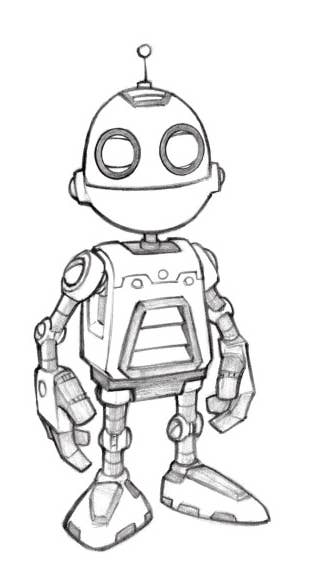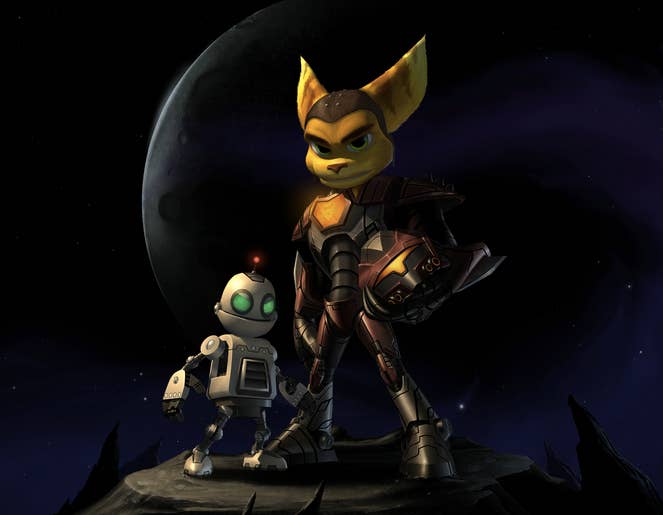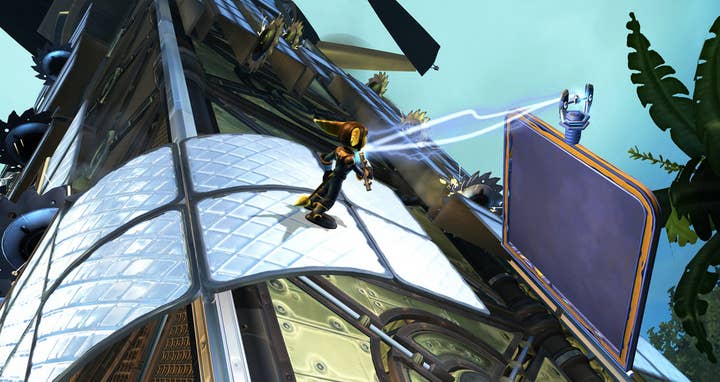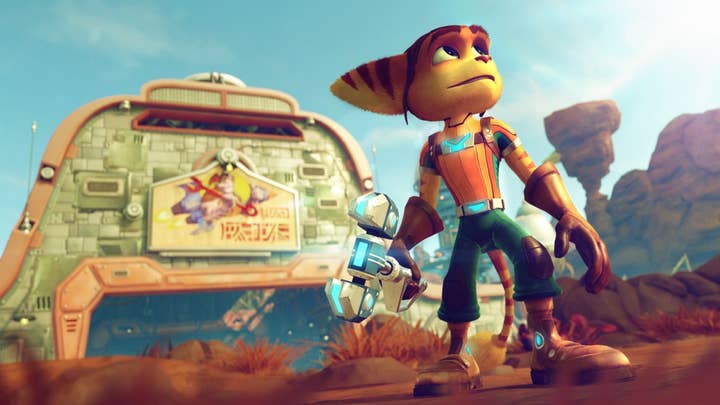"Don't get cocky": The story of Ratchet and Clank's 15-year survival
Adapt or Die and staying true to your heritage is a difficult balance to strike, says Insomniac
At GDC last week, Ratchet & Clank creators Insomniac took to the stage to discuss the series' 15-year history, spanning 14 different games.
Yet far from being a celebration of PlayStation's leading platform franchise, the talk acted as a post-mortem of the entire series, including the bits where the team got it very wrong.
"Ratchet & Clank started out as a girl with a stick," said director Brian Allgeier. "The codename of the game was 'girl with a stick'. It was a Zelda game mixed with Tomb Raider. But the team wasn't feeling it. So [studio head] Ted Price saw the writing was on the wall and killed it."
It was 2001. Insomniac had 35 staff working on the project, and they needed a new idea. Chief creative officer Brian Hasting jotted down a very generic pitch of 'an alien that travels from planet to planet, collecting weapons and gadgets'. It was simple, but the team took to the idea instantly.
After a few design fails, the team finally created the first designs of Ratchet - which Ted Price dubbed a 'Lombax' - and his sidekick Clank. Initially, one was the boss of the other, before the team decided to put them on equal footing. The desire was to create an 'Intergalactic' buddy cop movie that was "Lethal Weapon meets Saturday morning cartoons."
The idea was inspired by a series of familiar names and brands from inside and outside of video games: The Little Prince, Marvin the Martian, Star Wars, Conker's Bad Fur Day, Banjo-Kazooie, Super Metroid, Iron Giant, Super Mario 64 and The Legend of Zelda.
When drafting the prototype, the team couldn't get the initial PS2 tech to properly handle the long draw distances, so instead they worked with Mark Cerny to come up with dioramas that looked like a real game. It worked, the game was signed, the PS2 tech eventually improved, and Ratchet & Clank was born.
"First game was innovative and good," the studio said at GDC. "But it was RPG lite, and the weapons felt like they were optional.
"Ratchet & Clank didn't have a lot of depth as characters. Ratchet was also a bit of a dick, who was sarcastic and not overly likeable."

The firm decided to develop the characters, the weapons and the humour over the subsequent releases. Game No.2, Going Commando (2003), was even better received by fans, while the third title, Up Your Arsenal (2004), was its biggest hit yet.
At this stage, Insomniac had defined what it was that made Ratchet & Clank such a success. The game was a buddy story with a heart, featuring imaginative and strategic weapons, clever gadgets, the ability to explore planets, the comedic Captain Qwark, vibrant visuals, humour inspired by Douglas Adams and a decent balance between platforming and shooting.
Indeed, over the course of an hour-long GDC presentation, Insomniac pointed out how it was only when it failed to tick one or more of these boxes that it disappointed the fans.
By the third game, the studio had successfully evolved the series "from a platformer with shooting, to a shooter with platforming." Ratchet & Clank had a full strafing system and acted like a modern shooter.
Yet now Insomniac was growing concerned that the days of the 'mascot character' were fading away. It felt it needed to change to keep the series relevant.
"Adapt or die. Listen to what players want. Watch trends and amplify what makes your game stand out," Allgeier said.
The studio felt it had hit its stride with Up Your Arsenal, but its 'adapt or die' philosophy would inevitable lead to 'the fourth game slump'.
To avoid franchise fatigue, Insomniac took inspiration from the Halo series and created Ratchet: Deadlocked. The fourth game dropped the double entendre from the title, had removed Clank from the name ("which was not cool," admits the studio), was combat heavy and the game didn't feature the popular Qwark at all. It didn't tick half the boxes that made Ratchet & Clank so popular and the result was fans did not like it.
"It was a good game, but not a Ratchet & Clank game," Allgeier added. "It goes in the 'what were you thinking' category'."
Writer TJ Fixman said: "It featured no engaging buddy story. Reduced personality. We went overboard in shooting. We swung the needle too far from the franchise DNA."

Insomniac knew that going forward it would need to stick to the core pillars of the brand as much as possible, which is what it did when it moved onto the fifth game - Ratchet & Clank: Tools of Destruction (2007) on PS3.
This was a huge technical challenge for Insomniac, which had to re-do pretty much everything as it switched from PS2 to PS3. The team had promised to create a game that looked like a CG animated movie, and Allgeier was excited by all the capabilities of PS3. He set about with a long list of things he wanted to achieve, until someone at the studio wrote "Technology is evil" on the whiteboard.
In creating the PS3 launch game Resistance: Fall of Man, Insomniac had learnt not to try too much too soon with new technology. "You have to be careful with new tech, because it can be a lot of rope that you hang yourself with," Allgeier said.
With Tools of Destruction, Insomniac created a new engine with a higher fidelity of animation, but it scaled back the scope (this would be an origin story), it reduced the number of scenes, there was no multiplayer of any kind and no special modes, either.
This is where TJ Fixman came in to build a backstory and lore to the world of Ratchet & Clank. He wanted to establish the origins of both heroes and just build a world that could be developed in future games. He went in to nail down the broad elements, but also be as specific as possible and ensure that the hardcore fans were satisfied. "In crunch, it's easy to say 'nobody will notice'," Fixman said. "But they will."
Tools of Destruction focused on the core elements of the series and it worked. The firm set out a plan regarding the weapons. They either needed to be comedic, strategic or spectacular. Ideally all three. "We needed to hit a 10 in at least one of those categories," Allgeier said.
Mr Zurkon, for instance, was a robot sentry who wasn't the most powerful weapon, but was certainly hilarious. "I came up with a robot that liked to talk trash, but was really bad at it," joked Fixman. Then there was the Grooveatron, which stopped enemies by making them dance - something that certainly hit the mark in the strategic, comedic and spectacular columns.
"The game's cliffhanger ended made the fans feel a bit cheated. We probably wouldn't have done it if I got to do it again."
TJ Fixman, writer
Alongside the world-building and the new weapons, the company also pulled together a four-page document on the use of crates. Smashing crates is one of the core satisfactions that occurs in Ratchet & Clank, and Brian Hastings drew up rules in terms of the maximum crate number in any one area, how they were stacked and when to include explosive crates (to encourage players to throw the wrench).
Focusing and refining the core elements of Ratchet & Clank worked. Tools of Destruction was a return-to-form. The only negative? Fans were not happy with the game's cliff-hanger, which saw Clank abducted by the mysterious Zoni.
"The game's cliffhanger ended made the fans feel a bit cheated," Fixman noted. "We probably wouldn't have done it if I got to do it again."
As part of the initial pitch to Sony, Tools of Destruction was going to feature a co-op element, which was dropped. To satisfy the publisher, Insomniac offered to make a smaller product for a 2008 release.
"We had a freak out moment," Allgeier remembered. After discounting DLC, and the prospect of a space combat game, the firm decided to placate fans who were unhappy with the cliff-hanger ending by building a smaller, more experimental Ratchet & Clank.
That was the birth of Quest for Booty. The game experimented with dialogue trees, an open island to explore, and a wrench mechanic that allowed Ratchet to control objects to complete puzzles.

The game was very good, but fans weren't entirely satisfied. It was shorter title, the weapon upgrades had been removed and Captain Qwark was missing. But one of the biggest issues was 'teapot-gate'.
Quest for Booty featured a decapitated head on a stick, which would sing 'I'm A Little Teapot' to open doors. It was funny, until Insomniac discovered somebody owned the rights to the song "and they had lawyers," Allgeier revealed.
As Quest for Booty wasn't a full Ratchet & Clank game, it enabled Insomniac to take risks. It experimented with ideas, some of which would break through to the main game. It may not have entirely satisfied everybody, but it did a lot to inform where the series would go next.
And that was to 2009's A Crack in Time.
Insomniac considered this the series peak. It went out to make the final and ultimate Ratchet & Clank. A Crack in Time ticked every box in the franchise DNA, and then some. There was space flight and battles between the planets. There was time-being puzzles, and even small spherical worlds to explore. It also concluded the story, and did so by killing the villain - Dr Nefarious - by smashing him into a space station.
However, it did so well that Sony wanted another one.
"Don't get cocky," says Allgeier. "Every peak has its valley."
He continues: "Long-running franchises can get fatigue. We wanted to end the series there, and people wanted more. But reviewers were concerned that the game was getting long in the tooth."
The firm was also wary of the direction of family games, which seemed to be moving from consoles to mobile. So once again Insomniac went experimental.
All 4 One (2011) was a co-op game, which was almost called Ratchet & Clank: 4-play (the suggested title 'Multiple Organisms' was quickly dismissed). Sony wanted Dr Nefarious back, which forced TJ Fixman to come up with a way he survived the crash. He learned to never ring a bell that the publisher may want him to un-ring.
All 4 One was one of the best received Ratchet & Clank spin-offs, but it wasn't what fans wanted.
Nor did they want the next game, the tower defence-style Full Frontal Assault (2012).
Things improved when the franchise returned to its platforming heritage with Into the Nexus (2013). It was a decent title, but a short one and not quite the epic adventure that had characterised the main series so far.
Insomniac found itself trying to balance the three lessons it had learned so far in creating Ratchet & Clank. It was trying to embrace the unknown, adapt to market trends, whilst sticking to the franchise DNA. "Trying to stick that landing is very tricky," Allgeier said.
After creating six PS3 games based around Ratchet & Clank, Insomniac and Sony let the IP hibernate.
Yet its eventual return was to be signifiant, as Ratchet & Clank was getting the blockbuster movie treatment in 2016.

"We had some influence on the film, but we wanted to do right by the fans by creating a game that was based on the movie based on the game," joked Allgeier.
The firm had to deal with a few challenges. For starters, it was making a game in parallel to the movie. Although TJ Fixman put together the initial story, the film kept going through rewrites and Insomniac had to keep up.
The movie also deviated from the mythology of Ratchet & Clank. This was a tricky thing for the developers to manage, especially considering its loyalty to the core fans. It got around the issue by putting the game's story into the hands of an unreliable narrator - Captain Qwark - which allowed Insomniac to dodge inconsistencies as they arose.
The Ratchet & Clank reimagining went down very well with critics and fans, and its sales were the strongest since its the glory days of the PS2.
Where the series goes next, it's not clear. Insomniac has endured plenty of contradictions in creating Ratchet & Clank. It needs to adapt or die, but failure to stick to the franchise DNA will inevitably let the fans down.
The Ratchet & Clank reimagining is very much in the mould of the series that fans have loved. It didn't do anything drastically new, but proved that the game's core tenants remain fun. Insomniac now needs to work out where it goes from here.
"We took all the lessons we'd learned over the entire series and improved the game and brought it up to date," Allgeier concluded.
"We got a chance for a do-over, to fire our engines into the unknown."
